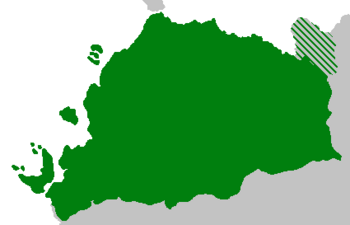Oscaunja
Jump to navigation
Jump to search
This article is incomplete because it is pending further input from participants, or it is a work-in-progress by one author. Please comment on this article's talk page to share your input, comments and questions. Note: To contribute to this article, you may need to seek help from the author(s) of this page. |
Kingdom of Oscaunja Rraigno do Oscaunja | |
|---|---|
Motto: Paies do Juorno
(Country of Day) | |
 | |
| Capital | Kastomarre |
| Largest city | Kassano |
| Official languages | Linj'Arrendino |
| Recognized languages | Linj' Imazinga |
| Ethnic groups | Arrendini- 40.5% Imazzingi- 28.25% Rriguani- 21.75% Aulerriano- 6.5% Suddani 2.9% Other 0.1% |
| Demonym(s) | Oscaundano |
| Government | Constitutional Monarchy |
• Rrai | Reney IV Raissuolli |
• Vocadir | Gian di Verdecoye |
| History | |
• Three Kingdom Period | 653-1043 AD |
• Unification of Oscaunja | 1044 AD |
• Respoblija do Oscaunja | 1791-1792 AD |
• Kingdom of Oscaunja | 1792-1858 AD |
• Republique de Civivaté et Allié | 1858-1904 AD (annexed by the Auvernia) |
• Kingdom Restored | 1919 AD |
• Independence Regained | 1927 AD |
| Population | |
• 1936 estimate | 11,000,000 |
| GDP (PPP) | estimate |
• Total | 14.8 Billion Dollars |
| Currency | Oscaundano Duocado |
| Driving side | right |
The Kingdom of Oscaunja (Arrendino: Rraigno do Oscaunja; Alpanian: Regnum Auschonia), is a constitutional kingdom on the Northwestern coast of Nymera in the world of Verthandi. Founded in 1044 A.D. by Guillamo I the Unifier, Oscaunja remained an independent power for most of its history, until its annexation by the Auvernian Federation in 1904. Independence was regained following the deposition of Rrai Reney III and a short but bloody civil war in 1927.


